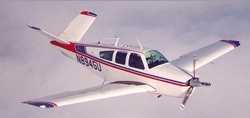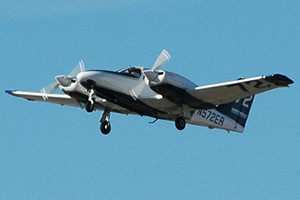Accident Resulted In One Fatal Injury
Two pilots involved in a mid-air collision in St. Paul, OR in October, 2011 were unable to see each other to avoid a mid-air collision, according to probable cause reports released by the NTSB. Two reports were released, one for each of the airplanes involved. The same conclusion was reached in each report. The pilot of a Beech Bonanza was fatally injured as a result of the collision. The two people aboard a Piper twin engaged in flight instruction were uninjured.

According to the report, a Beech V35 and Piper PA-44-180 collided in flight in a common practice area for airwork. The flight instructor in the Piper reported that at an altitude of about 7,500 feet mean sea level (msl), he told the pilot receiving instruction to conduct a simulated emergency descent. The instructor stated that the pilot receiving instruction executed the simulated emergency descent and recovered to cruise flight at an altitude of about 4,500 feet msl before they continued toward a local airport. As the flight continued, the instructor observed a single-engine airplane that appeared to be on a converging course, and he transmitted a position report on the intended destination airport's common traffic advisory frequency. The instructor stated that after making a slight heading change and descent, he re-established visual contact with a single-engine airplane, which was then behind and above the Piper’s position. He then scanned the area ahead of the Piper’s position from
left to right. The instructor said he then felt a jolt along with a violent shudder in the airplane followed by an uncommanded left roll and yaw. The instructor took control of the airplane and made a forced landing to a nearby open field.
Review of recorded radar data revealed that the Piper was on a northwesterly heading at 7,700 feet msl when it initiated a right descending turn. Meanwhile, the Beech was traveling on a continuous northeasterly heading at an altitude of about 2,400 feet msl. The last recorded radar target for each airplane before the collision showed that the airplanes were on converging paths; the Piper was at 2,800 feet msl on a northeasterly heading and maneuvering west of the Beech, which was at an altitude of about 2,400 feet msl on a north-northeasterly heading. During examination of the recovered wreckage, transfer marks were identified consistent with the radar-derived collision angle. Both airplanes were operating in visual conditions when they collided.

Based on relative positions of the airplanes, and given the other airplane traffic in the area, it seems likely that the single-engine airplane the Piper instructor observed before the collision was not the Beech with which the collision occurred. It could not be determined if either pilot could see the other just before the collision; however, based on the airplanes’ relative positions and flight attitudes, it seems unlikely. The Piper was maneuvering in a left bank at the time and it is likely that the Piper’s wing and engine blocked the Beech from the Piper pilot's field of vision. Additionally, the Beech pilot’s view of the Piper, which was above and to the left of his flight path, would likely have been blocked by the airplane’s door post and cabin roof structure.
The National Transportation Safety Board determines the probable cause(s) of this accident to be:
The pilot was unable to see the other aircraft to avoid a collision.
(Images from file. Not accident airplanes)
 ANN's Daily Aero-Term (05.17.24): Very High Frequency
ANN's Daily Aero-Term (05.17.24): Very High Frequency ANN's Daily Aero-Linx (05.17.24)
ANN's Daily Aero-Linx (05.17.24) ANN FAQ: Submit a News Story!
ANN FAQ: Submit a News Story! Classic Aero-TV: ANN Visits Wings Over The Rockies Exploration Of Flight
Classic Aero-TV: ANN Visits Wings Over The Rockies Exploration Of Flight Airborne Affordable Flyers 05.16.24: PRA Runway, Wag-Aero Sold, Young Eagles
Airborne Affordable Flyers 05.16.24: PRA Runway, Wag-Aero Sold, Young Eagles




